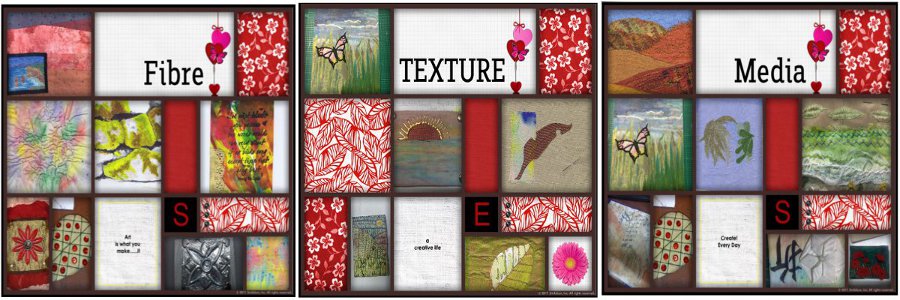Each sample has been felted onto cotton and batting and includes a strand of un needlefeted yarn to the extreme right of each picture.
Quotes (in italics) on yarn definition are from wikipedia
Eyelash
"These are made from a polyester fiber with a furry texture resembling eyelashes. These novelty yarns are made of a thin central ply surrounded by short "hairs"."
Although I am discussing this yarn under eyelash, it is more properly called a fur yarn." fur yarns have an abundance of threads covering the entirety of the core thread"
This yarn has a core of two satiny threads twisted. and the fur or lashes are very feathery. It attaches well and especially on cotton, where it makes a lovely soft texture on the back.
This is a very shiny, satiny eyelash, with the lashes very close together and straight, however the fine satin lashes are not stiff and so felt well. The lashes from several lengths can be felted down into an all over texture, but Iprefer to felt down only the braid backbone and leave the lashes free.
This is another very hard to see yarn,a narrow satiny twist with lurex "fur". It attaches only loosely, the lurex threads being very crisp and not soft and the core being very tightly woven. It is probably better if this yarn is couched, but it can be loosely tacked down first using the embellisher.
This is a great, soft eyelash, which has very loose lashes, like roving or slub.
"A slub or thick spot in a yarn is created by varying the tightness of the twist of the yarn at various intervals" However, thick, minimally twisted yarn is also referred to as slub or roving.
This yarn felts readily and forms an irregular line of felted material, although the lashes can be left loose. On cotton, thr transfer to the back is very dark and it can be useful for adding colour from the back.
Although at first glance this might appear to be a fur type of yarn, it is actually an eyelash with very long, fluffy lashes. It felts readily, because of the fluffines of the lashes and I have found it extremely useful in defining hilltops in landscapes as it gives an irregular line, like trees or bushes in the distance.
This is another, slub-like eyelash and it also felts extremely well. If used from the back of a piece it adds colour very well.
This last yarn is a mix of several things. It has a twisted core, into which are twisted puffs of slub as well as lurex fibres, which create a fur rather than an eyelash. The core felts a little, the fur not at all, however the puffs felt extremely well and hold the rest of the yarn in place. I have also found yarn with puffs like this to be useful for adding dots of colour either from the front or back. If on the front of a piece, the core and fur is clipped off afterward, leaving a nice little dot of colour. This is great, especially to indicate rocks, or flowers in the distance.
So eyelash is a very useful yarn for embellishing:
- Usually, the core or backbone will felt in nicely, leaving the lashes free
- Lurex and other plastic fibres will not felt on their own, but can be attached when blended with another fibre either in the lurex yarn itself, or by twisting it with one.
- Eyelash yarns are useful in landscapes because of their one-sidedness
- Eyelash with slub-like lashes are very good felters, from both the fron and back with different effects for each.
Happy embellishing








